9-30-09 - No sunspots today
Current conditions
Solar wind
speed: 343.3 km/sec
density: 1.5 protons/cm3
explanation |
more data
Updated: Today
at 2345 UT
X-ray Solar Flares
6-hr max: A9
2110 UT Sep30
24-hr: A9
2110 UT Sep30
explanation |
more data
Updated: Today
at: 2340 UT
Cosmic Rays Hit Space Age High
09.29.2009
September 29, 2009: Planning a trip to Mars? Take
plenty of shielding. According to sensors on NASA's ACE (Advanced
Composition Explorer) spacecraft, galactic cosmic rays have just
hit a Space Age high.
"In
2009, cosmic ray intensities have increased 19% beyond anything
we've seen in the past 50 years," says Richard Mewaldt of Caltech.
"The increase is significant, and it could mean we need to
re-think how much radiation shielding astronauts take with them on
deep-space missions."
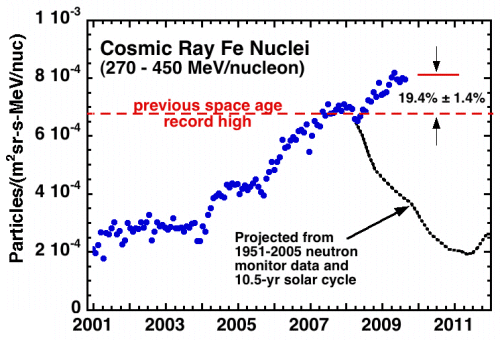
Above: Energetic iron nuclei counted by the
Cosmic Ray Isotope Spectrometer on NASA's ACE spacecraft reveal
that cosmic ray levels have jumped 19% above the previous Space
Age high. [larger
image]
The
cause of the surge is solar minimum, a deep lull in solar activity
that began around 2007 and continues today. Researchers have long
known that cosmic rays go up when solar activity goes down. Right
now solar activity is as weak as it has been in modern times,
setting the stage for what Mewaldt calls "a perfect storm of
cosmic rays."
"We're
experiencing the deepest solar minimum in nearly a century," says
Dean Pesnell of the Goddard Space Flight Center, "so it is no
surprise that cosmic rays are at record levels for the Space Age."
Galactic cosmic rays come from outside the solar system. They are
subatomic particles--mainly protons but also some heavy
nuclei--accelerated to almost light speed by distant supernova
explosions. Cosmic rays cause "air showers" of secondary particles
when they hit Earth's atmosphere; they pose a health hazard to
astronauts; and a single cosmic ray can disable a satellite if it
hits an unlucky integrated circuit.
The
sun's magnetic field is our first line of defense against these
highly-charged, energetic particles. The entire solar system from
Mercury to Pluto and beyond is surrounded by a bubble of magnetism
called "the heliosphere." It springs from the sun's inner magnetic
dynamo and is inflated to gargantuan proportions by the solar
wind. When a cosmic ray tries to enter the solar system, it must
fight through the heliosphere's outer layers; and if it makes it
inside, there is a thicket of magnetic fields waiting to scatter
and deflect the intruder.
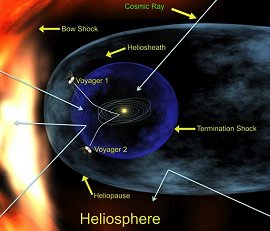
An
artist's concept of the heliosphere, a magnetic bubble that
partially protects the solar system from cosmic rays. [larger
image]
"At
times of low solar activity, this natural shielding is weakened,
and more cosmic rays are able to reach the inner solar system,"
explains Pesnell.
Mewaldt lists three aspects of the current solar minimum that are
combining to create the perfect storm:
1. The sun's magnetic field is weak. "There has
been a sharp decline in the sun's interplanetary magnetic field
down to 4 nT (nanoTesla) from typical values of 6 to 8 nT," he
says. "This record-low interplanetary magnetic field undoubtedly
contributes to the record-high cosmic ray fluxes." [data]
2. The solar wind is flagging. "Measurements by
the Ulysses spacecraft show that solar wind pressure is at a
50-year low," he continues, "so the magnetic bubble that protects
the solar system is not being inflated as much as usual." A
smaller bubble gives cosmic rays a shorter-shot into the solar
system. Once a cosmic ray enters the solar system, it must "swim
upstream" against the solar wind. Solar wind speeds have dropped
to very low levels in 2008 and 2009, making it easier than usual
for a cosmic ray to proceed. [data]
3. The current sheet is flattening. Imagine the
sun wearing a ballerina's skirt as wide as the entire solar system
with an electrical current flowing along its wavy folds. It's
real, and it's called the "heliospheric current sheet," a vast
transition zone where the polarity of the sun's magnetic field
changes from plus to minus. The current sheet is important because
cosmic rays are guided by its folds. Lately, the current sheet has
been flattening itself out, allowing cosmic rays more direct
access to the inner solar system.
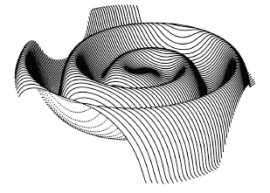
The
heliospheric current sheet is shaped like a ballerina's skirt.
Image credit: J. R. Jokipii and B. Thomas, Astrophysical Journal
243, 1115, 1981.
"If
the flattening continues, we could see cosmic ray fluxes jump all
the way to 30% above previous Space Age highs," predicts Mewaldt.
[data]
Earth is in no great peril. Our planet's atmosphere and magnetic
field provide some defense against the extra cosmic rays. Indeed,
we've experienced much worse in the past. Hundreds of years ago,
cosmic ray fluxes were at least 200% to 300% higher than anything
measured during the Space Age. Researchers know this because when
cosmic rays hit the atmosphere, they produce an isotope of
beryllium, 10Be, which is preserved in polar ice. By
examining ice cores, it is possible to estimate cosmic ray fluxes
more than a thousand years into the past. Even with the recent
surge, cosmic rays today are much weaker than they have been at
times in the past millennium. [data]
"The space era has so far experienced a time of relatively low
cosmic ray activity," says Mewaldt. "We may now be returning to
levels typical of past centuries."
NASA spacecraft will continue to monitor the situation as solar
minimum unfolds. Stay tuned for updates.
Author:
Dr. Tony Phillips | Credit:
Science@NASA
|
9-29-09 - Sunspot 1026 is gone - 1027 is right on the edge of
the sun
Current conditions
Solar wind
speed: 310.4 km/sec
density: 2.0 protons/cm3
explanation |
more data
Updated: Today
at 2346 UT
X-ray Solar Flares
6-hr max: A0
1810 UT Sep29
24-hr: A3
1125 UT Sep29
explanation |
more data
Updated: Today
at: 2340 UT
SPACE
WEATHER ON MERCURY: Today,
NASA's MESSENGER spacecraft is going to
fly by Mercury only 142 miles from the planet's
surface. Naturally, much attention will be given to
pictures of new craters and previously unseen terrain,
but there is another, equally sensational reason for
the flyby--namely, to investigate Mercury's
hyperactive space weather:
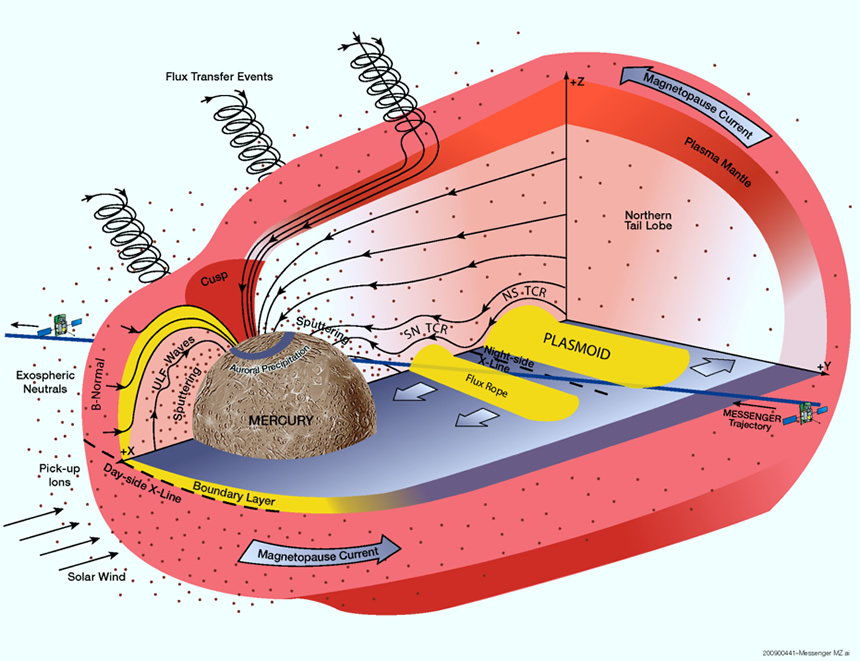
Mercury's magnetic field is buffeted by solar wind
as much as fifteen times stronger than the solar wind
we experience at Earth. During an earlier flyby of
Mercury in Oct. 2008, MESSENGER encountered magnetic
"tornadoes" – twisted bundles of magnetic fields
connecting Mercury to interplanetary space. The
twisters are formed by explosive
magnetic reconnection events at the solar
wind-magnetic field boundary. Solar wind can actually
flow down the throats of these tornadoes to strike and
erode the surface of Mercury, giving Mercury a
comet-like tail.
MESSENGER will fly right through this maelstrom of
magnetism and solar wind en route to buzzing Mercury's
surface. Stay tuned for data!
|
9-28-09 - Sunspot 1026 is fading away - 1027 is heading for the
edge of the sun.
Current conditions
Solar wind
speed: 341.3 km/sec
density: 4.4 protons/cm3
explanation |
more data
Updated: Today
at 2344 UT
X-ray Solar Flares
6-hr max: A1
2245 UT Sep28
24-hr: A2
1415 UT Sep28
explanation |
more data
Updated: Today
at: 2340 UT
JUST FOUR
MORE INCHES... In 1976, NASA's
Viking 2 lander dug into the soil of Mars in search of
water and came up dry. NASA has just learned that
Viking 2 might have succeeded if it had dug only 4
inches deeper. Meteorites hitting the Red Planet in
2008 and 2009 have exposed subsurface deposits of ice
in the general area where Viking 2 landed. According
to pictures taken by the Mars Reconnaissance Orbiter,
the ice is surprisingly close to the surface in easy
reach of robotic landers or thirsty human explorers.
Get the
full story from Science@NASA.
|
9-27-09 - Sun photo is still from the 25th
Current conditions
Solar wind
speed: 314.1 km/sec
density: 4.5 protons/cm3
explanation |
more data
Updated: Today
at 2347 UT
X-ray Solar Flares
6-hr max: A0
2215 UT Sep27
24-hr: A5
0045 UT Sep27
explanation |
more data
Updated: Today
at: 2340 UT
This weekend, comes NEAR the comet
217P/LINEAR Classification:
Jupiter-family Comet [NEO] SPK-ID:
1000345
Ephemeris | Orbit
Diagram | Orbital
Elements | Physical
Parameters | Discovery
Circumstances | Close-Approach
Data ]
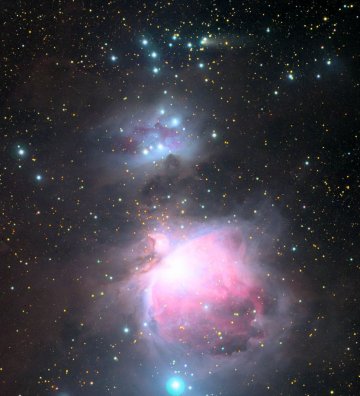 Italian amateur astronomer Rolando Ligustri took the
picture on Sept. 26th using a 4-inch wide field
Global Rent-a-Scope in New Mexico. He needed 15
minutes of exposure time to reveal the green comet
among the gas and dust of Orion's great star-forming
region. The comet is receding from the nebula now,
but still close enough for some nice parting shots.
Astrophotographers who wish to try can use
this JPL ephemeris to point their telescopes.
Good luck!
Italian amateur astronomer Rolando Ligustri took the
picture on Sept. 26th using a 4-inch wide field
Global Rent-a-Scope in New Mexico. He needed 15
minutes of exposure time to reveal the green comet
among the gas and dust of Orion's great star-forming
region. The comet is receding from the nebula now,
but still close enough for some nice parting shots.
Astrophotographers who wish to try can use
this JPL ephemeris to point their telescopes.
Good luck!(In case you're still looking, the
comet is
here.)
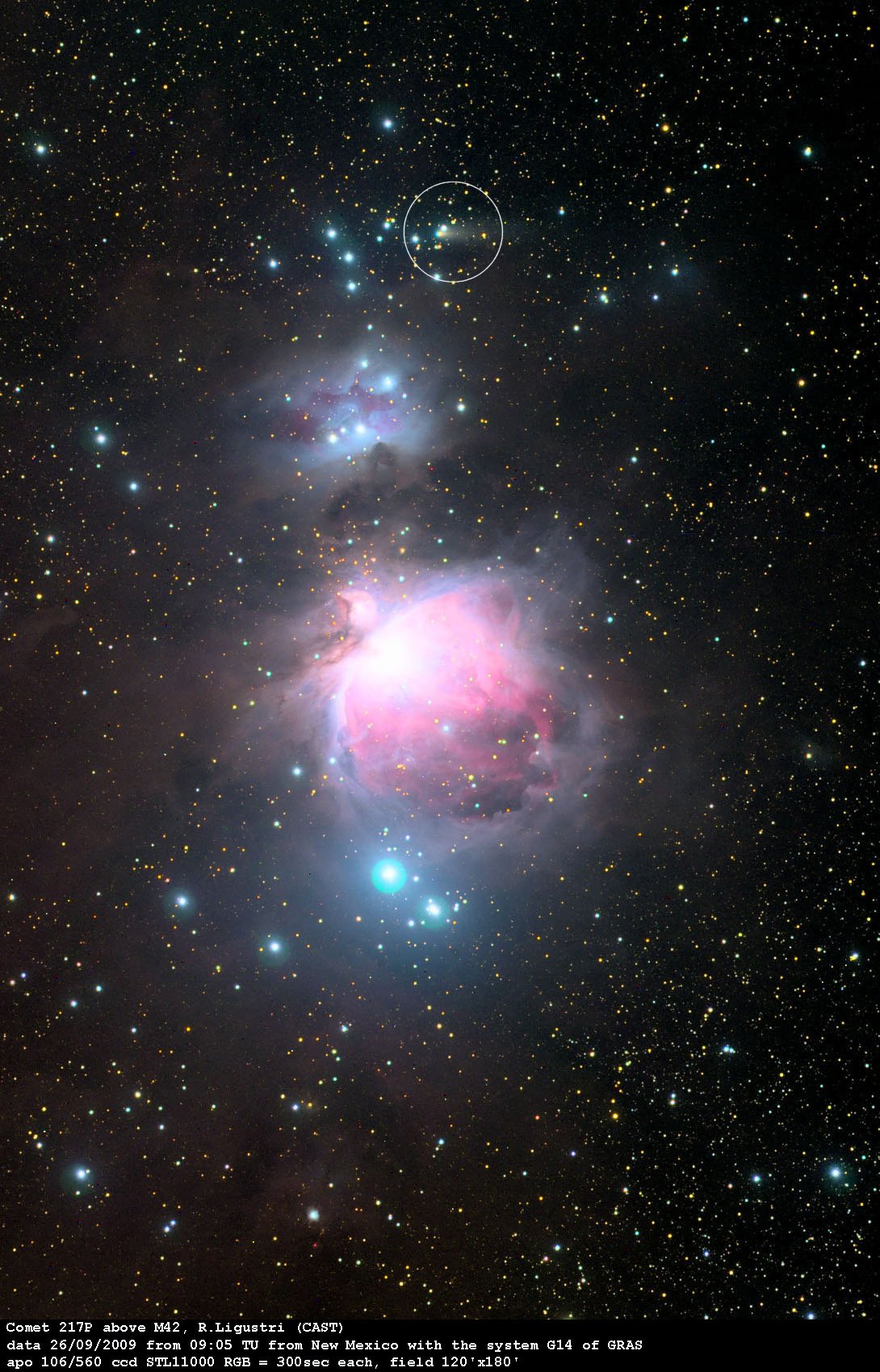
|
| 9-26-09 - Sunspots 2016 and 1027 continue to shine SOLAR
ACTIVITY: Around the world,
amateur astronomers are watching an impressive display
of solar prominence activity. "Wow and then some!"
exclaims from Steve Riegel who sends this picture from
Santa Maria, California:
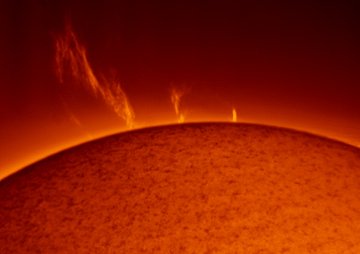
"This is by far the biggest prominence I've seen
since I got my
Personal Solar Telescope in 2005," he says. "I
hope this is a taste of things to come as we start
climbing out of solar minimum."
more images:
from Emiel Veldhuis of Zwolle, the Netherlands;
from Francisco A. Rodriguez of Cabreja Mountain
Observatory, Canary Islands;
from Pete Lawrence of Selsey, West Sussex, UK;
from Cai-Uso Wohler of Bispingen, Germany;
from P-M Hedén of Ålbo, Sweden;
from Fabio Mariuzza of Biauzzo, Italy;
from Rich Schueller of Massachusetts;
Current conditions
Solar wind
speed: 319.3 km/sec
density: 1.0 protons/cm3
explanation |
more data
Updated: Today
at 2345 UT
X-ray Solar Flares
6-hr max: A0
1955 UT Sep26
24-hr: A2
1220 UT Sep26
explanation |
more data
Updated: Today
at: 2340 UT
Meteorite Impacts Expose Ice on Mars
09.24.2009
September 24, 2009: Meteorites recently striking
Mars have exposed deposits of frozen water not far below the
Martian surface. Pictures of the impact sites taken by NASA's Mars
Reconnaissance Orbiter show that frozen water may be available to
explorers of the Red Planet at lower latitudes than previously
thought.
"This ice is a relic of a more humid climate from perhaps just
several thousand years ago," says Shane Byrne of the University of
Arizona, Tucson.
Byrne is a member of the team operating the orbiter's High
Resolution Imaging Science Experiment, or HiRISE camera, which
captured the unprecedented images. Byrne and 17 co-authors report
the findings in the Sept. 25 edition of the journal
Science.
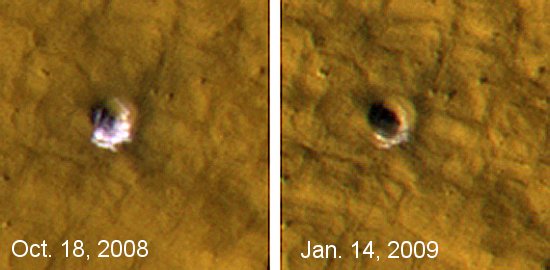
Above: A fresh, 6-meter-wide, 1.33-meter-deep
crater on Mars photographed on Oct. 18, 2008, and again on Jan.
14, 2009, by Mars Reconnaissance Orbiter's HiRISE camera. The
bright material is ice, which fades from Oct. to Jan. because of
sublimation and obscuration by settling dust. [more]
"We
now know we can use new impact sites as places to look for ice in
the shallow subsurface," adds Megan Kennedy of Malin Space Science
Systems in San Diego, a co-author of the paper and member of the
team operating the orbiter's Context Camera.
So
far, the camera team has found bright ice exposed at five Martian
sites with new craters that range in depth from approximately half
a meter to 2.5 meters (1.5 feet to 8 feet). The craters did not
exist in earlier images of the same sites. Bright patches darkened
in the weeks following initial observations, as freshly exposed
ice vaporized into the thin Martian atmosphere.
The
finds indicate water-ice occurs beneath Mars' surface halfway
between the north pole and the equator, a lower latitude than
expected in the dry Martian climate.
During a typical week, the spacecraft's Context Camera returns
more than 200 images of Mars that cover a total area greater than
California. The camera team examines each image, sometimes finding
dark spots that fresh, small craters make in terrain covered with
dust. Checking earlier photos of the same areas can confirm a
feature is new. In this way, the team has found more than 100
fresh impact sites.
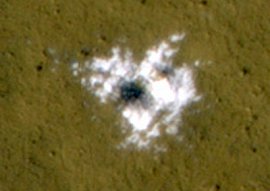
An
image from the camera on Aug. 10, 2008, showed apparent cratering
that occurred after an image of the same ground was taken 67 days
earlier. The opportunity to study such a fresh impact site
prompted a look by the orbiter's higher resolution camera on Sept.
12, 2009, confirming a cluster of small craters.
Right: The patch of ice exposed at this late-2008
crater was large enough for the orbiter's spectrometers to take
readings and confirm that it is H2O. [more]
"Something unusual jumped out," Byrne said. "We observed bright
material at the bottoms of the craters with a very distinct color.
It looked a lot like ice."
The
bright material at that site did not cover enough area for a
spectrometer instrument on the orbiter to determine its
composition. "Was it really ice?" the team wondered. The answer
came from another crater with a much larger area of bright
material.
"We
were excited [when we saw it], so we did a quick-turnaround
observation," said co-author Kim Seelos of Johns Hopkins
University Applied Physics Laboratory in Laurel, Md. "Everyone
thought it was water-ice, but it was important to get the spectrum
for confirmation."
Mars Reconnaissance Orbiter Project Scientist Rich Zurek, of
NASA's Jet Propulsion Laboratory, Pasadena, Calif., said, "This
mission is designed to facilitate coordination and quick response
by the science teams. That makes it possible to detect and
understand rapidly changing features."
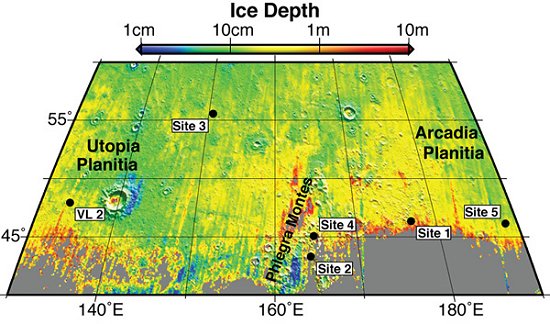
Above: This map shows five locations where fresh
impact cratering has excavated water ice from just beneath the
surface of Mars (sites 1 through 5) and the Viking Lander 2
landing site (VL2), in the context of color coding to indicate
estimated depth to ice. [more]
The
ice exposed by fresh impacts suggests that NASA's Viking Lander 2,
digging into mid-latitude Mars in 1976, might have struck ice if
it had dug only 10 centimeters (4 inches) deeper. The Viking 2
mission, which consisted of an orbiter and a lander, launched in
September 1975 and became one of the first two space probes to
land successfully on the Martian surface. The Viking 1 and 2
landers characterized the structure and composition of the
atmosphere and surface. They also conducted on-the-spot biological
tests for life on another planet.
To
view images of the craters and learn more about the Mars
Reconnaissance Orbiter visit
http://www.nasa.gov/mro.
Editor:
Dr. Tony Phillips | Credit:
Science@NASA
http://www.nasa.gov/mission_pages/MRO/news/mro20090924.html |
| 9-25-09 - Sunspots 1026 and 1027 are in the center of the sun
now SOLAR
FLARE: New-cycle sunspot 1026
is crackling with magnetic activity, and this morning
it produced a
C-class solar flare. The Solar and Heliospheric
Observatory's (SOHO's) extreme UV telescope recorded
the action around 0100 UT on Sept. 25th:
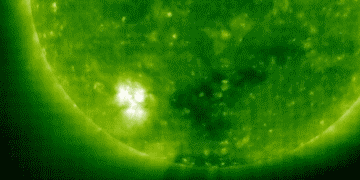
If you thought that flare seemed small, you were
right. It was about 100-times too weak too affect
Earth. During Solar Maximum, such a minor eruption
would probably go unnoticed and certainly unmentioned.
But during the
deepest solar minimum in almost 100 years, it's a
big event. A C-flare! The blast raised no radio
blackouts or radiation storms--only the hopes of solar
observers for something more flamboyant.
Stay tuned.
sunspot photos:
from Pete Lawrence of Selsey, West Sussex, UK;
from Andy Yeung of Hong Kong;
from John C McConnell of Maghaberry Northern
Ireland.;
from Trevor Little on the south coast of England;
from Francisco A. Rodriguez of Cabreja Mountain
Observatory, Canary Islands;
from Richard Best of Sussex, England;
from Fabio Mariuzza of Biauzzo, Italy;
from Jörgen Blom of Stockholm, Sweden;
from Pavol Rapavy of Observatory Rimavska Sobota,
Slovakia
Current conditions
Solar wind
speed: 281.9 km/sec
density: 1.7 protons/cm3
explanation |
more data
Updated: Today
at 2342 UT
X-ray Solar Flares
6-hr max: A7
2030 UT Sep25
24-hr: C1
0100 UT Sep25
explanation |
more data
Updated: Today
at: 2340 UT
Lieida professor spots large asteroid over
1 kilometre in diameter, 645,000 miles from Earth.
After six days of monitoring by
the Minor Planet Centre at the University of Harvard, it has
been termed, asteroid 2009 ST19.
Lieida professor spots large asteroid over 1 kilometre in
diameter, 645,000 miles from Earth.
Professor Josep Maria Bosc from the Field Learning Observation Centre
of the Universe, discovered the asteroid on September 16 from his
observatory, on Montmagastrell Santa Maria (Lleida) , which in real
terms means the asteroid came the closest to Earth than any other in
the past.
After six days of monitoring by the Minor Planet Centre at the
University of Harvard, it has been termed, asteroid 2009 ST19. This is
classed as an Apollo, a potentially dangerous kind to the planet
because its orbit overlaps with that of Earth. The asteroid is also
the largest, at more than a kilometre in diameter, that has come close
to Earth. At the time of its closest approach it passed 645,000 miles
abve the Earth.
The last similar incident dates back to 1937, when the asteroid Hermes
passed 750,000 miles over the Earth.
|
| 9-24-09 - TWO sunspots - James McCanney stated on
coasttocoastam.com radio show that the sun cycle has been thrown off a
couple of years by a large comet that came through our space several
years ago, so that we won't hit the peak sun cycle until about 2014 -
and then 'look out' because when the sunspots take off, it will be
worse than expected.
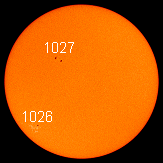
Sunspots 1026 and1027 are
members of new Solar Cycle 24. Photo credit: SOHO/MDI
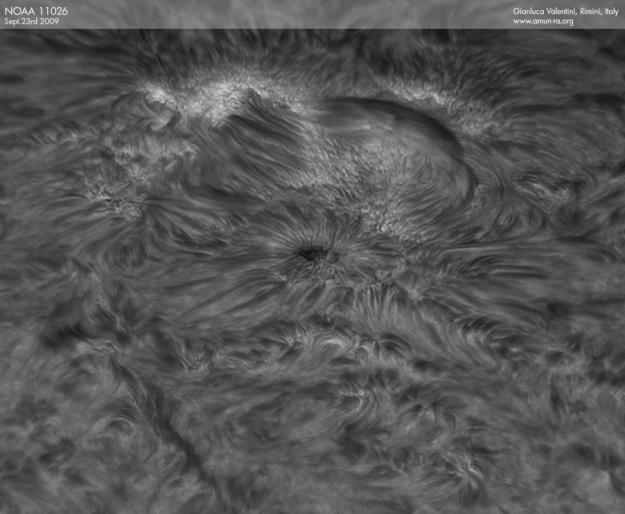
more sunspot images:
from Gianluca Valentini of Rimini, Italy;
from Ingmar Glas of Weißenfeld, Bavaria, Germany;
from Dr. Wayne Wooten of Pensacola Junior College,
Pensacola, Florida;
from Robert Arnold of Isle of Skye, Scotland;
from Athanasios Georgiou of Filyro, Greece;
from Gianluca Valentini of Rimini, Italy;
from Fulvio Mete of Rome, Italy;
Current conditions
Solar wind
speed: 288.9 km/sec
density: 0.2 protons/cm3
explanation |
more
data
Updated: Today at 1205
UT
X-ray Solar Flares
6-hr max: A3 0640
UT Sep24
24-hr: A9 0020 UT
Sep24
explanation |
more data
Updated: Today at: 1200
UT
|
| 9-23-09 - Two sunspots
SOLAR
ACTIVITY: "Finally, the sun
seems to be waking up," says astrophotographer Pete
Lawrence. "There is a lot going on around new sunspot
1026. The spot's dark core is surrounded by active
fibrils and a swirling magnetic filament that gives
the region a nice 3D appearance." He took this picture
using a Solarscope SF70:
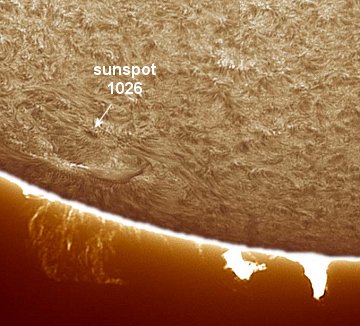
"Moreover," he adds, "a second sunspot has
appeared, number 1027, and it is growing rapidly."
Two big sunspots in one day? That hasn't happened
in more than a year. Two is not enough to end the
deepest solar minimum in a century; nevertheless, it
is a welcome interruption. Readers with
solar telescopes are encouraged to monitor
developments.
more images:
from Chin Wei Loon of As-syams Solar Observatory,
University of Malaya, Malaysia;
from Adrian Guzman of San Jose, California;
from Guenter Kleinschuster of Feldbach, Austria;
from Vahan Yeterian of Lompoc, California;
from John C McConnell of Maghaberry Northern
Ireland;
from Francisco A. Rodriguez of Cabreja Mountain
Observatory, Canary Islands;
from Peter Paice of Belfast, Northern Ireland;
Current conditions
Solar wind
speed: 302.5 km/sec
density: 0.4 protons/cm3
explanation |
more data
Updated: Today
at 2247 UT
X-ray Solar Flares
6-hr max: A4
1955 UT Sep23
24-hr: A7
0800 UT Sep23
explanation |
more data
Updated: Today
at: 2340 UT
|
| 9-22-09 - sunspot is still on the edge of the sun SUNSPOT UPDATE:
A second sunspot is emerging to join the one reported
below:
SOHO image. This is the first time in more than a
year that two relatively-large sunspots have shared
the Earth-facing side of the sun.
SUNSPOT 1026: One sunspot is
not enough to end the deepest solar minimum in nearly
a century, but you've got to start somewhere.
"Finally, a new sunspot!" says Paul Maxson who sends
this picture from his observatory in Surprise,
Arizona:
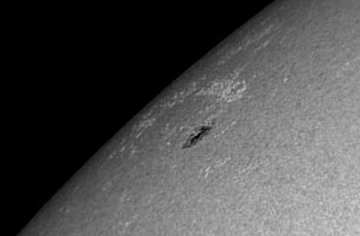
Sunspot 1026 emerged yesterday to break a string of
19 consecutive spotless days. It's about as wide as
Earth, which makes it an easy target for backyard
solar telescopes. The Solar and Heliospheric
Observatory (SOHO) has measured the spot's magnetic
polarity and identified it as a member of new Solar
Cycle 24. Could this be a harbinger of more to come? (Apparently
so.) Stay tuned.
more images:
from Pete Lawrence of Selsey, West Sussex, UK;
from Michał Nyklewicz of Poland;
from Athanasios Georgiou of Filyro, Greece;
from Jan Koeman of Kloetinge, The Netherlands;
from Peter Paice of Belfast, Northern Ireland;
from Emiel Veldhuis of Zwolle, the Netherlands;
from Alan Friedman of Buffalo, NY;
from Eva Vidovic of Stojnci, Slovenia;
from A.Cote, W. Frame and John Stetson of South
Portland, Maine.
Current conditions
Solar wind
speed: 384.3 km/sec
density: 0.2 protons/cm3
explanation |
more data
Updated: Today
at 2344 UT
X-ray Solar Flares
6-hr max: B3
2040 UT Sep22
24-hr: B3
2040 UT Sep22
explanation |
more data
Updated: Today
at: 2340 UT
Today is the
equinox, but the sun came up directly east yesterday, so
the sun is still off schedule from the norm.
|
| 9-21-09 - sunspot finally coming around the corner.
EMERGING
SUNSPOT: Today, a new sunspot
is emerging over the sun's eastern limb. It doesn't
appear to be the solar minimum-breaking behemoth some
observers had hoped for, but it is the first sunspot
in almost three weeks and a welcome break from the
quiet. Astrophotographer Pete Lawrence sends this
picture from his backyard observatory in Selsey, UK:
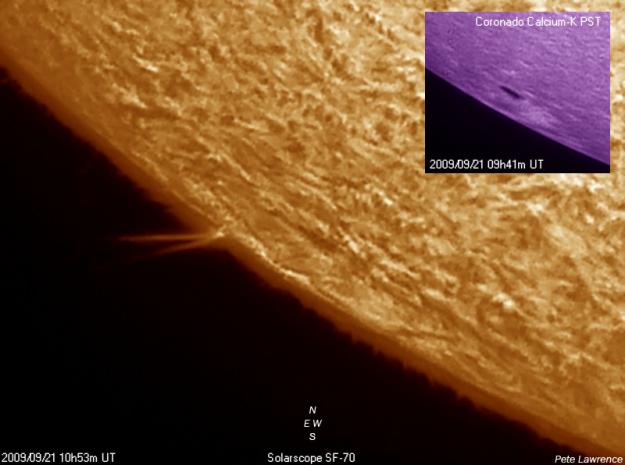
The high southern latitude of the spot
identifies it as a member of new Solar Cycle 24. We'll
get a better view later today as the sun's rotation
turns the active region more squarely toward Earth.
Readers with
solar telescopes are encouraged to monitor
developments.
more images:
from Emiel Veldhuis of Zwolle, the Netherlands;
from Alan Friedman of Buffalo, NY;
from Eva Vidovic of Stojnci, Slovenia;
from A.Cote, W. Frame and John Stetson of South
Portland, Maine;
from CJ Wood of Ridgely, Maryland
Current conditions
Solar wind
speed: 407.5 km/sec
density: 0.2 protons/cm3
explanation |
more data
Updated: Today
at 2338 UT
X-ray Solar Flares
6-hr max: A2
2310 UT Sep21
24-hr: B1
1255 UT Sep21
explanation |
more data
Updated: Today
at: 2340 UT
Jupiter Turned Comet Into "Moon"
for 12 Years
September 21, 2009
ago,
Jupiter carried on a 12-year fling with an extra
"moon" then casually cast it aside—and the gas giant
will likely do it again within decades, scientists
announced today.
In 1949 the massive planet's gravity pulled in
comet 147P/Kushida-Muramatsu and held it in orbit
until 1961, according to an international team led
by Katsuhito Ohtsuka of the Tokyo Meteor Network.
The 1,300-foot-wide (400-meter-wide) comet's
stint as a so-called temporary satellite was
revealed when the researchers used calculations
taken since the comet's 1993 discovery to determine
the space rock's past course.
"We can be fairly sure that the comet orbited
Jupiter once or twice before escaping it," said team
member David Asher of the U.K.'s Armagh Observatory.
Temporary "Moon" Ended With a Bang
Only one temporary satellite has been observed
falling prey to a planet's pull: comet
Shoemaker-Levy 9, which broke apart and crashed into
Jupiter in 1994. (See a
Hubble Space Telescope picture of comet debris
approaching Jupiter.)
A
mysterious debris plume spotted on Jupiter this past
July may have been caused by the spectacular
impact of another such temporary satellite, Asher
said.
Unlike those objects, comet Kushida-Muramatsu
eventually escaped Jupiter's gravity. It currently
circles the sun in the solar system's asteroid belt,
between the orbits of Mars and Jupiter.
Before long, though, another comet is destined
for moondom. Between 2068 and 2086, comet
111P/Helin-Roman-Crockett is expected to be captured
and complete six laps around Jupiter, the
astronomers say.
Earth Unlikely to Gain Extra Moon
It's doubtful that our own planet would have the
gravitational pulling power to add a temporary
satellite to the night sky, Asher said.
"There are examples of small objects that the
Earth had captured and then escaped again, so it
could in principal happen," Asher said.
"But with one of these larger objects—objects big
enough to cause serious damage, were they to impact
the Earth—fortunately they are much more likely to
be captured by Jupiter"—sparing Earth a potential
Armageddon.
Findings presented today at the European
Planetary Science Congress in Potsdam, Germany.
LATEST NEWS VIDEOS


 SOURCES AND RELATED WEB SITES
SOURCES AND RELATED WEB SITES
|
| 9-20-09 - FARSIDE SUNSPOT: NASA's STEREO-B spacecraft is
tracking an active region over the sun's eastern horizon that could be
a large, new-cycle sunspot. We can't yet see it from Earth, but the
sun's rotation is turning the region toward us, and it could pop into
view as early as Sept. 21st. Readers with solar telescopes should
monitor the sun's eastern limb for developments.
APPROACHING
SUNSPOT: NASA's STEREO-B spacecraft
stationed over the sun's eastern limb is monitoring an active
region not yet visible from Earth. STEREO's extreme
ultraviolet telescope captured this image on Sept. 19th:
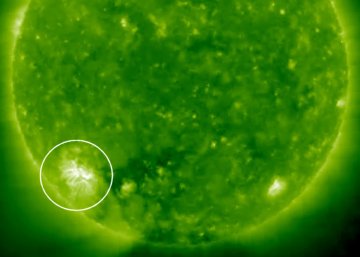
The tangle of hot, magnetized plasma circled above almost
certainly overlies a large new-cycle sunspot. We'll soon find
out. The sun's rotation is turning the active region toward
Earth and it could pop over the sun's eastern limb as early as
Sept. 21st. Readers with
solar telescopes are encouraged to monitor developments.
Current conditions
Solar wind
speed: 328.8 km/sec
density: 0.1 protons/cm3
explanation |
more
data
Updated: Today at 1846
UT
X-ray Solar Flares
6-hr max: A2 1255
UT Sep20
24-hr: A4 0110 UT
Sep20
explanation |
more data
Updated: Today at: 1845
UT
|
9-19-09 - Wonder what happened to that sunspot that
was supposedly coming around the corner of the sun. No sign of
it yet.
SATURDAY
NIGHT LIGHT SHOW: The phones
started ringing around 7:30 pm EDT on Saturday night,
Sept. 19th. All along the US Atlantic seaboard, police
stations and news desks received reports of strange
lights in the sky. John A. Blackwell of Exeter, New
Hampshire, snapped this picture of the phenomenon:
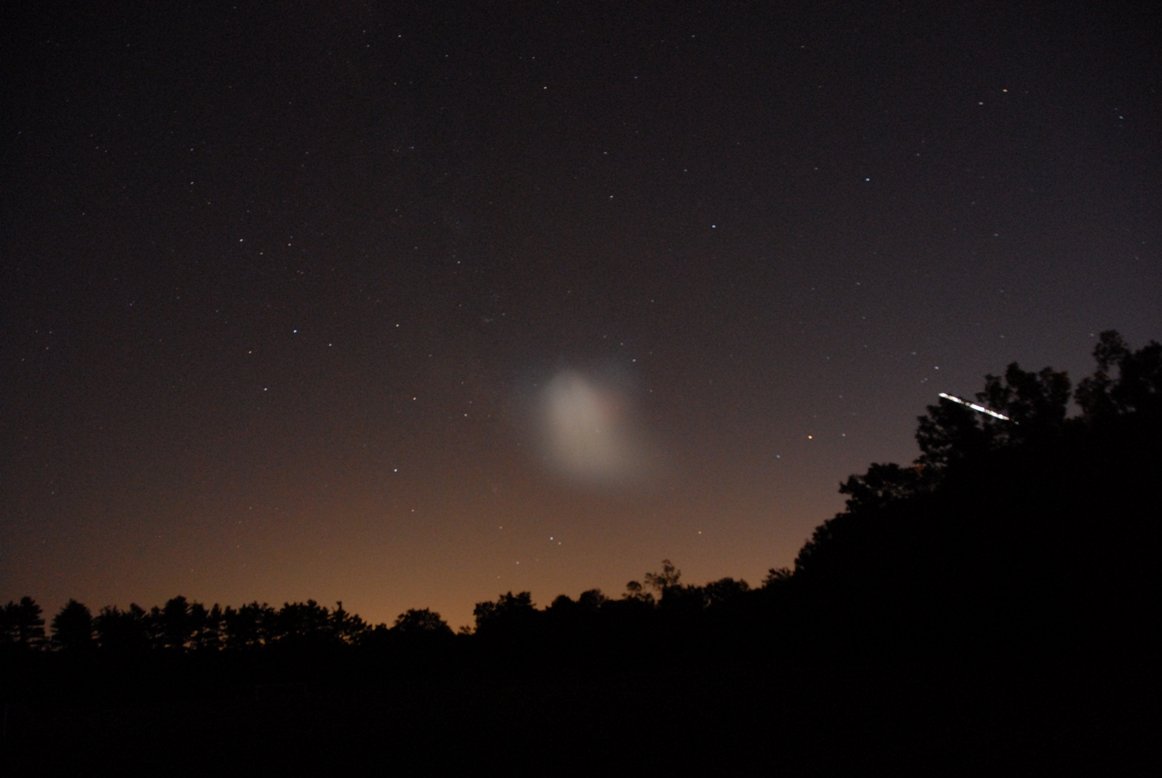
"It was an impressive display," says
Blackwell. "To the naked eye, it was visible for about
a minute."
It looks like a passing comet or a
giant, luminous amoeba. But this was pure rocket
science. The cloud was created by a Black Brant XII
sounding rocket launched from NASA's Wallops Flight
Facility in Virginia. The rocket released a cloud of
electrically-charged aerosols near the top of Earth's
atmosphere to investigate the formation of noctilucent
clouds or "NLCs."
Mysterious NLCs form naturally around Earth's
poles during the months of northern summer. On this
September evening, researchers decided to see if they
could create an artificial NLC at mid-latitudes; it
seems to have worked.
Ground-based cameras and radars along
the Atlantic coast monitored the experiment while the
STPSat-1 satellite watched from Earth orbit. Principal
investigators at the Naval Research Lab hope the data
will reveal much about the microphysics of
noctilucent clouds and the possible
role of rockets in creating them.
more images:
from Neil Winston of Lusby, Maryland;
from Geoff Chester of Alexandria, Virginia;
from Greg Piepol near Manassas, Virginia;
from Tom McIntyre of Central Park, New York;
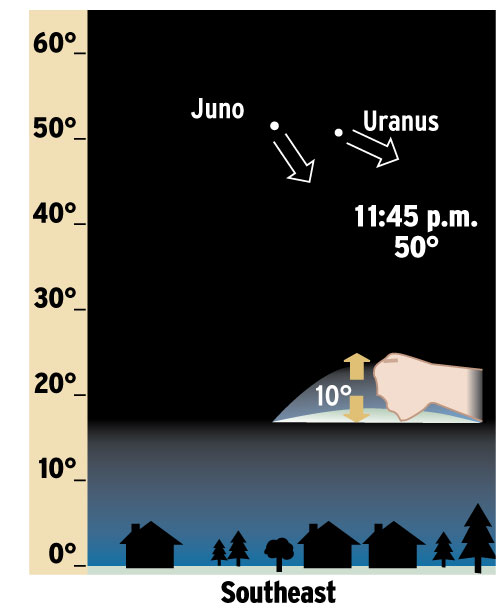
Graphic by Cindy O'Dell,
Orange County Register
Juno was discovered by astronomer Karl
L. Harding on Sept.1, 1804. You’ll need a small telescope and a bit of
patience. But now through early next week, you should
be able to spot
asteroid
Juno streaking through the cosmos, high above the
southeast horizon, says NASA. We suggest that you look
for Juno shortly before midnight, roughly 50 degrees
above the southeast. (Hold your arm out straight. Make
the bottom of your fist even with the horizon. A fist
is about 10 degrees tall, astronomically speaking.)
Juno, which is about 145 miles in diameter, will
reach its maximum brightness on Monday night. But
astronomers say you can see it now, and its worth
taking a look. From our perspective, this is the
brightest Juno will be until 2018. And you’ll be
seeing a stony mass that astronomers say may represent
about 1 percent of the entire mass in the asteroid
belt. You’ll also be looking at something of an
optical illusion. Juno will appear like it is not
moving. But the asteroid is actually traveling about
49,000 mph, on a path that’s about 112 million miles
from Earth. It also rotates once every 7 hours and 21
minutes.

Courtesy of
Harvard-Smithsonian Center for Astrophysics. (NM
stands for nanometers. The asteroid was photographed
from the Mt. Wilson Observatory in varying
wavelengths.)
Earlier on
Sciencedude:
Current conditions
Solar wind
speed: 388.4 km/sec
density: 0.0 protons/cm3
explanation |
more
data
Updated: Today at 1617
UT
X-ray Solar Flares
6-hr max: A1 1310
UT Sep19
24-hr: A1 1310 UT
Sep19
explanation |
more data
Updated: Today at: 1610
UT
VENUS HAS A
SIDEKICK: Look east just before
dawn on Sunday morning, Sept. 20th. There's Venus, as
usual, shining through the rosy glow of sunrise. A pair of
binoculars trained on Venus reveals a sidekick:
1st-magnitude star Regulus less than 0.5o away.
It's a one-day-only conjunction, so don't oversleep:
sky map.
|
9-18-09 - No sunspots today - Still waiting for the new sunspot to
come around the corner.
Current conditions
Solar wind
speed: 396.9 km/sec
density: 0.5 protons/cm3
explanation |
more
data
Updated: Today at 1736
UT
X-ray Solar Flares
6-hr max: A0 1535
UT Sep18
24-hr: A0 1535 UT
Sep18
explanation |
more data
Updated: Today at: 1735
UT
|
9-17-09 - No sunspots today - Watching for the new sunspot
coming around the corner soon.
Current conditions
Solar wind
speed: 461.5 km/sec
density: 0.8 protons/cm3
explanation |
more
data
Updated: Today at 1656
UT
X-ray Solar Flares
6-hr max: A0 1645
UT Sep17
24-hr: A0 1645 UT
Sep17
explanation |
more data
Updated: Today at: 1645
UT
|
9-16-09 - A sunspot is forming on the far side of the sun.
It should be coming around the corner shortly.
Current conditions
Solar wind
speed: 424.0 km/sec
density: 1.4 protons/cm3
explanation |
more data
Updated: Today
at 2347 UT
X-ray Solar Flares
6-hr max: A0
2340 UT Sep16
24-hr: A0
0535 UT Sep16
explanation |
more data
Updated: Today
at: 2340 UT
FARSIDE
SUNSPOT: A big sunspot appears
to be growing on the far side of the sun. Yesterday,
the National Solar Observatory's
GONG
network detected helioseismic echoes from the
sunspot's gathering magnetic field. Today, NASA's
STEREO-B spacecraft is beaming back images of an
active region peeking over the sun's far-eastern
limb--exactly where
GONG
data predicted it would be:
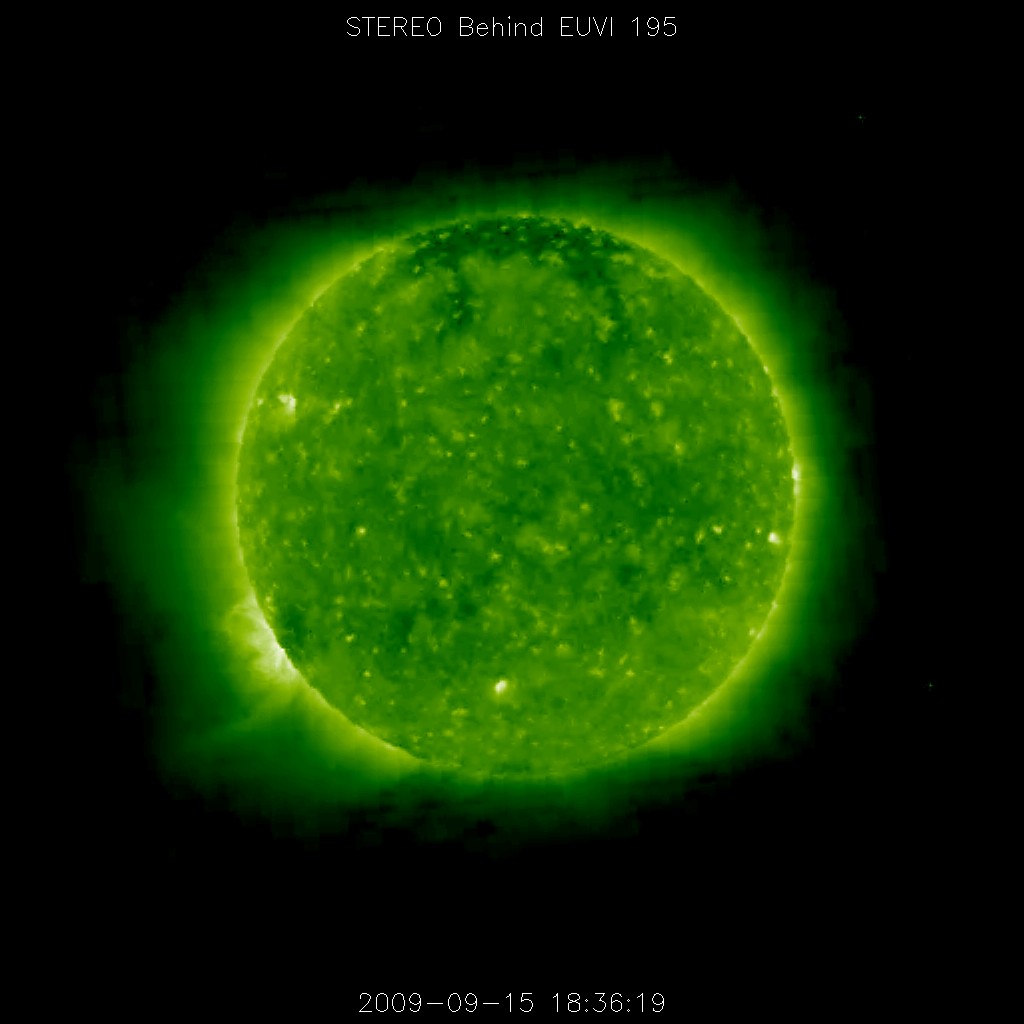
Photo credit: STEREO-B Extreme UV
Telescope
Irene Gonzalez-Hernandez, a solar
physicist working on the GONG project, says "I believe
this is a large active region belonging to new Solar
Cycle 24. The sun's rotation should turn it toward
Earth for direct viewing on Sept. 20th."
Until then, the
sunspot number remains pegged at zero. Why?
Because farside sunspots do not count. Back in the
19th century when the sunspot number was invented,
astronomers had no way of monitoring events on the
farside of the sun, so no provision was made for
adding farside spots to the total. Fast forward to
2009: NASA has two spacecraft (STEREO-A and -B)
maneuvering for a
360o view of the entire sun, and by the
year 2011 no sunspot will escape their detection. A
more modern way of counting sunspots may soon be
required.
|
9-15-09 - No sunspots today
Current conditions
Solar wind
speed: 450.4 km/sec
density: 2.1 protons/cm3
explanation |
more data
Updated: Today
at 2344 UT
X-ray Solar Flares
6-hr max: A0
2340 UT Sep15
24-hr: A0
2340 UT Sep15
explanation |
more data
Updated: Today
at: 2340 UT
SOLAR ACTIVITY:
Today, the Solar
and Heliospheric Observatory (SOHO) is
monitoring an enormous prominence on the
sun's southeastern limb. Behold three
hours of fiery action:
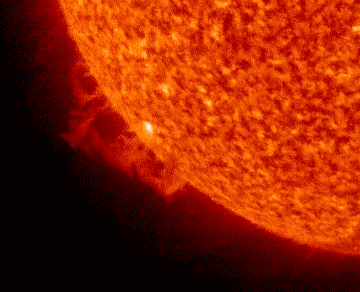
The prominence has been
growing for more than a day. As it towers
higher and higher above the surface of the
sun, the odds increase that it will erupt
and come crashing down--a must-see.
Readers, if you have a
solar telescope, train your optics on
the sun's southeastern limb.
more images:
from J. Macieszek and J. Stetson of
South Portland, Maine
|
9-14-09 - No sunspots today
Current conditions
Solar wind
speed: 409.6 km/sec
density: 2.1 protons/cm3
explanation |
more data
Updated: Today
at 2343 UT
X-ray Solar Flares
6-hr max: A0
2340 UT Sep14
24-hr: A0
2340 UT Sep14
explanation |
more data
Updated: Today
at: 2340 UT
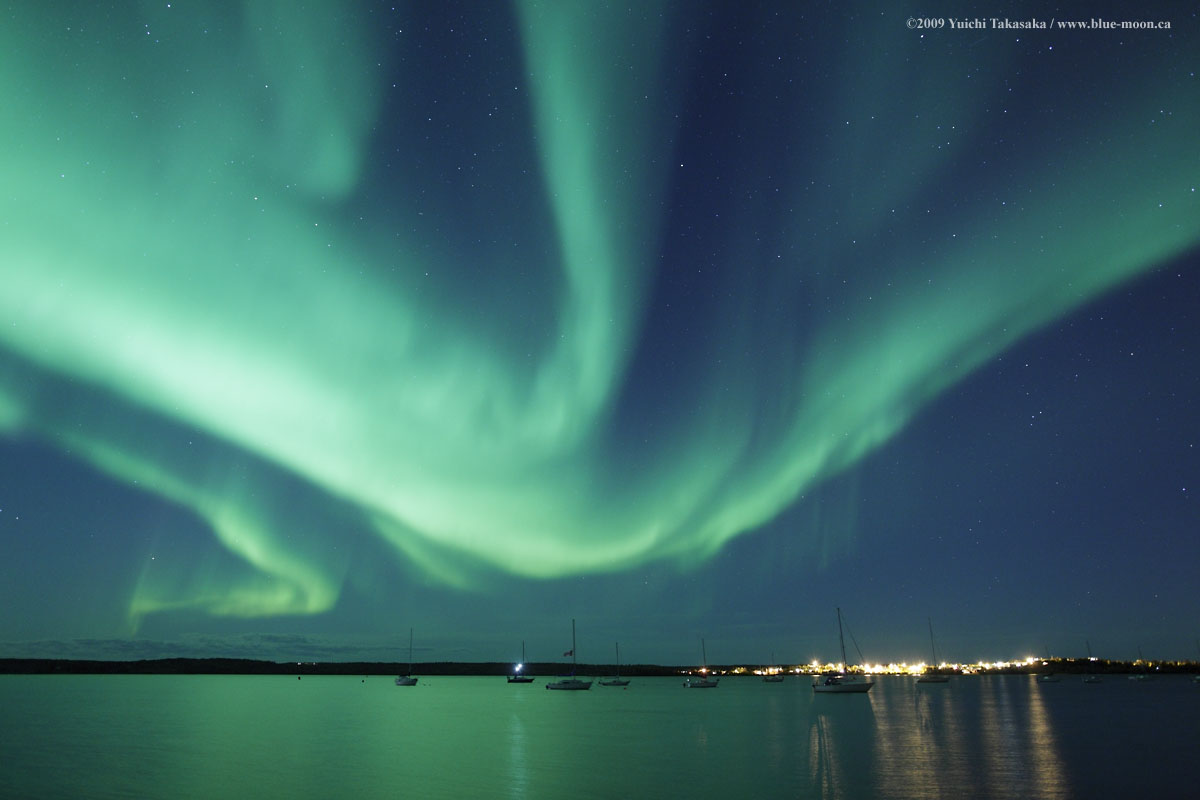
Yellowknife on Sept. 12th," writes Yuichi Takasaka from the
Northwest Territories of Canada. "Northern Lights started to
appear from 10pm local time and stayed well after 4am!"
|
9-13-09 - No sunspots today
Current conditions
Solar wind
speed: 360.2 km/sec
density: 3.2 protons/cm3
explanation |
more data
Updated: Today
at 2346 UT
X-ray Solar Flares
6-hr max: A0
2340 UT Sep13
24-hr: A0
2340 UT Sep13
explanation |
more data
Updated: Today
at: 2340 UT
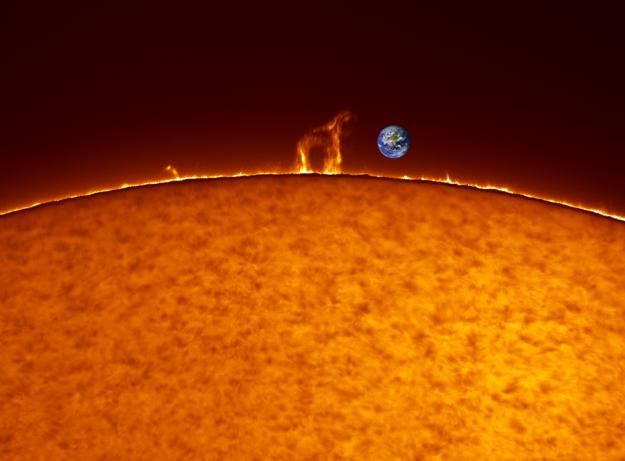
SOLAR PROMINENCE WITH EARTH BEYOND?
WHERE WAS THE CAMERA?
sun shots:
from Greg Piepol of Rockville, Maryland;
from Erika Rix of Zanesville, Ohio;
from Cai-Uso Wohler of Bispingen, Germany;
from Michael Borman of Evansville, Indiana;
|
9-12-09 - No sunspot today Current conditions
Solar wind
speed: 322.5 km/sec
density: 0.7 protons/cm3
explanation |
more
data
Updated: Today at 1502
UT
X-ray Solar Flares
6-hr max: A0 1505
UT Sep12
24-hr: A0 1505 UT
Sep12
explanation |
more data
Updated: Today at: 1505
UT
LUNAR IMPACT:
NASA's Lunar Crater Observation and
Sensing Satellite (LCROSS) is on a collision course with
the Moon. At a briefing yesterday, NASA announced exactly
where the impact will take place.
NASA Selects Target Crater for Lunar
Impact
09.11.2009
Sept. 11, 2009: NASA's Lunar Crater
Observation and Sensing Satellite (LCROSS) is racing
toward a double-impact on the moon at 7:30 am EDT on
Oct. 9th. Today NASA announced exactly where the crash
will take place.
The target crater is Cabeus A. It was selected after
an extensive review of the best places to excavate
frozen water at the lunar south pole.

Above: Craters of interest around the
lunar south pole. LCROSS is targeting Cabeus A. Image
credit: NMSU/MSFC Tortugas Observatory.
"The selection of Cabeus A was a result of a vigorous
debate within the lunar science community. We reviewed
the latest data from Earth-based observatories and our
fellow lunar missions Kaguya, Chandrayaan-1, and the
Lunar Reconnaissance Orbiter," says Anthony Colaprete,
LCROSS project scientist and principle investigator at
NASA's Ames Research Center. "The team is looking
forward to wealth of information this unique mission
will produce."
LCROSS will search for ice by plunging its spent
upper-stage Centaur rocket into the permanent shadows
of Cabeus A, where water might be trapped in frozen
form. The LCROSS satellite will then fly into the
plume of debris kicked up by the impact and measure
the properties of the plume before it also collides
with the lunar surface.
The LCROSS team selected Cabeus A based on a set of
conditions that includes favorable illumination of the
debris plume for visibility from Earth, where
astronomers will be watching closely. Cabeus A also
has a high concentration of hydrogen (a constituent of
water, H2O) and favorable terrain such as a
flat floor, gentle slopes and the absence of large
boulders.
Professional astronomers will use many of Earth's most
capable observatories to monitor the impacts. These
observatories include the Infrared Telescope Facility
and Keck telescope in Hawaii; the Magdalena Ridge and
Apache Ridge Observatories in New Mexico and the MMT
Observatory in Arizona; the newly refurbished Hubble
Space Telescope; and the Lunar Reconnaissance Orbiter,
among others.
Amateur astronomers can monitor the impact, too.
Observing tips may be found
here.
"Telescopes participating in the LCROSS Observation
Campaign will provide observations from different
vantage points using different types of measurement
techniques," says Jennifer Heldmann, lead for the
LCROSS Observation Campaign at Ames. "These multiple
observations will complement the LCROSS spacecraft
data to help determine whether or not water ice exists
in Cabeus A."
 During
a media briefing Sept. 11, Daniel Andrews, LCROSS
project manager at Ames, provided a mission status
update: The spacecraft is healthy and has enough fuel
to successfully accomplish all mission objectives.
Andrews also announced the dedication of the LCROSS
mission to the memory of legendary news anchor, Walter
Cronkite, who provided coverage of NASA's missions
from the beginning of America's manned space program
to the age of the space shuttle. During
a media briefing Sept. 11, Daniel Andrews, LCROSS
project manager at Ames, provided a mission status
update: The spacecraft is healthy and has enough fuel
to successfully accomplish all mission objectives.
Andrews also announced the dedication of the LCROSS
mission to the memory of legendary news anchor, Walter
Cronkite, who provided coverage of NASA's missions
from the beginning of America's manned space program
to the age of the space shuttle.
Right: The LCROSS mission has been
dedicated to the memory of Walter Cronkite, who
covered NASA missions from Mercury through the space
shuttle. Image credit: CBS News. [more]
"Dad would sure be proud to be part, if just in name,
of getting humans back up to the moon and beyond,"
says Chip Cronkite, son of the famed news anchor.
"We're looking forward to October 9th," Andrews says.
"The next 28 days will undoubtedly be very exciting."
Cabeus A, here we come!

THE SHUTTLE APPEARS AS A COMET WHILE VENTING
The photo was taken on a
30-second exposure at ISO 500.
(Submitted by
Clair Perry Photography)
A P.E.I. photographer has snapped a couple of rare
pictures that has people in the astronomy world talking.
Clair Perry had his camera set up Wednesday night to
take a picture of the space shuttle passing over
Charlottetown. As he watched the point of light cross the sky,
he was surprised to see it sprout a comet-like tail. He
captured the image on his camera.
"We were blown away. We thought, ooh, we've got
something here," said Perry.
"I sent two of them off to space weather by 10:30 and I
thought I have a good feeling that this would make the front
page of spaceweather.com."
One of the pictures did make the front page on Thursday.
Perry speculated that what he had caught was reflected
sunlight diffused through clouds in the upper atmosphere.
Spaceweather.com reported that the shuttle was scheduled to
make several wastewater dumps at about the time Perry took his
pictures.
That would make the flare virtually identical to a
comet's tail, which comes from water evaporated off the comet
as it approaches the sun.
Was Vancouver light show a meteor or space
junk
By Canwest News Service,
Vancouver Proivnce
September 13, 2009
VANCOUVER — It wasn’t a bird and it wasn’t a
plane. Was it a meteor?At approximately 8
p.m. Saturday night, a great, big ball of
yellowy-white light streaked from east to west
across the darkening sky.
Astronomer David Dodge said that the
fireball was probably a meteor — basically a
rock falling from space.
“It probably wasn’t a piece of space junk.
The reason why I say that is that it was going
from east to west, and 99.9 per cent of space
stuff sent up there is not going east to
west.”
He said meteors fall to Earth every day.
Most burn up before they enter the Earth’s
atmosphere.
Dodge said if it was a meteor, it might
have landed somewhere along Vancouver Island’s
west coast or in the Pacific Ocean — if it
landed at all.
Vancouver Province
© Copyright (c) The Province
|
9-11-09 - No sunspots today
Solar wind
speed: 298.5 km/sec
density: 2.4 protons/cm3
explanation |
more data
Updated: Today
at 2345 UT
X-ray Solar Flares
6-hr max: A0
2340 UT Sep11
24-hr: A0
2340 UT Sep11
explanation |
more data
Updated: Today
at: 2340 UT
|
9-10-09 - No sunspots today
Current conditions
Solar wind
speed: 302.9 km/sec
density: 1.5 protons/cm3
explanation |
more data
Updated: Today
at 2344 UT
X-ray Solar Flares
6-hr max: A0
2340 UT Sep10
24-hr: A0
2340 UT Sep10
INNER
SPACE TERRANAUTS: This week,
while astronauts orbited high above Earth installing
new science equipment in the laboratories of the
International Space Station, a team of
terranauts
descended into the Earth on their own mission of
discovery. "We were not in outer space, but inner
space," says explorer George Kourounis, who sends this
picture from the
Cave of Crystals in Naica, Mexico:
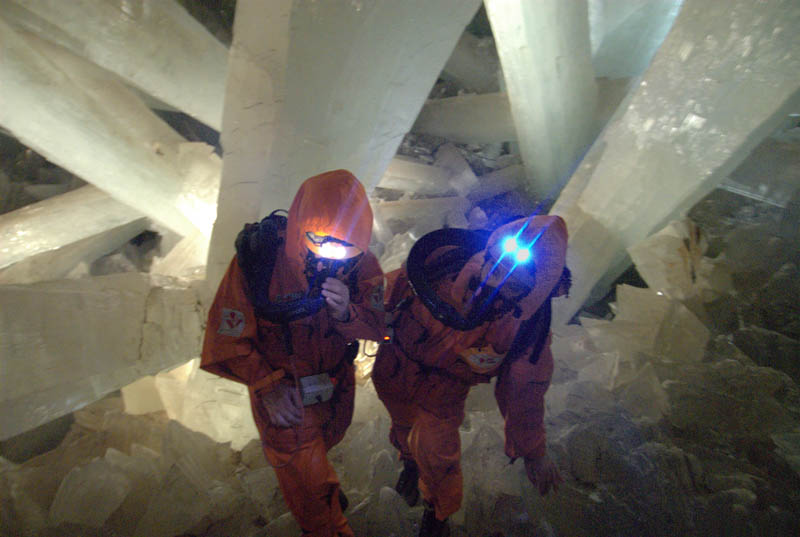
more images:
#2,
#3,
#4
Three hundred meters below Naica lies an alien
world of giant crystals and nearly unbearable heat.
"With an air temperature of 122 F and a relative
humidity of more than 90%, it feels like 228 F in the
cave," says Kourounis. "To survive in this extreme
environment, we enter the cave wearing special suits
with cooling packs inside and a backpack respirator
which allows us to breath chilled air. Even with all
this equipment, I will still be able to stay in the
cave for no more than 45 minutes at a time."
Unprotected, even a scant 10 minutes could prove
fatal--and that is why this amazing cavern discovered
by miners nine years ago remains relatively
unexplored. "Some of the crystals are 11 meters long
and weigh as much as 55 tons," marvels Kourounis. "We
had to be extremely cautious not to slip and fall.
Doing so could get you impaled."
"Wearing the suit," he adds, "you feel like an
astronaut who is about to go on a space walk." Make
that an inner space walk.
Click here for more pictures and anecdotes from
the Cave of Crystals.
August 2009 Aurora Gallery
[previous Augusts:
2008,
2007,
2006,
2005,
2004,
2003,
2002,
2001]
Explore the Sunspot Cycle
|
9-9-09 - No sunspots today
Current conditions
Solar wind
speed: 300.1 km/sec
density: 2.2 protons/cm3
explanation |
more data
Updated: Today
at 2347 UT
X-ray Solar Flares
6-hr max: A0
2340 UT Sep09
24-hr: A0
0145 UT Sep09
explanation |
more data
Updated: Today
at: 2340 UT
Spectacular First Images from the Rejuvenated
Hubble Space Telescope09.08.2009
September 9, 2009: Astronomers have declared
NASA's Hubble Space Telescope a fully rejuvenated observatory with
the release of observations from four of its six operating science
instruments. Sen. Barbara Mikulski of Maryland unveiled the images
today at NASA Headquarters in Washington, DC.
"This marks a new beginning for Hubble," said Ed Weiler, associate
administrator for NASA's Science Mission Directorate. "The
telescope was given an extreme makeover and now is significantly
more powerful than ever, well-equipped to last into the next
decade."

Above: A selection of images from the rejuvenated
Hubble:
more.
View the complete gallery
Topping the list of new views are colorful, multi-wavelength
pictures of far-flung galaxies, a densely packed star cluster, an
eerie "pillar of creation," and a "butterfly" nebula. Hubble's
suite of new instruments allows it to study the universe across a
wide swath of the light spectrum, from ultraviolet all the way to
near-infrared. In addition, scientists released spectroscopic
observations that slice across billions of light-years to probe
the cosmic-web structure of the universe and map the distribution
of elements that are fundamental to life as we know it.
"I
fought for the Hubble repair mission because Hubble is the
people's telescope," said Mikulski, chairwoman of the Commerce,
Justice and Science Appropriations Subcommittee that funds NASA.
"I also fought for Hubble because it constantly rewrites the
science textbooks. It has more discoveries than any other science
mission. Hubble is our greatest example of our astronauts working
together with scientists to show American leadership and
ingenuity."
"I
want to salute Team Hubble -- everyone who worked on Hubble from
the Goddard Space Flight Center and Space Telescope Science
Institute scientists in Maryland, to the ground crew at the
Kennedy Space Center, to the Johnson Space Center where the
astronauts train, and to the astronauts who were heroes in space,"
she concluded.
The
new instruments are more sensitive to light and, therefore, will
improve Hubble's observing efficiency significantly. It is able to
complete observations in a fraction of the time that was needed
with prior generations of Hubble instruments. The space
observatory today is significantly more powerful than it ever has
been.

Above: A sample spectrum obtained by Hubble's new
Cosmic Origins Spectrograph (COS). More examples of COS data may
be found
here and
here.
The
new results are compelling evidence of the success of the STS-125
servicing mission in May, which has brought the space observatory
to the apex of its scientific performance. Two new instruments,
the Wide Field Camera 3 and Cosmic Origins Spectrograph, were
installed, and two others, the Advanced Camera for Surveys and
Space Telescope Imaging Spectrograph, were repaired at the circuit
board level. Mission scientists also announced that the Near
Infrared Camera and Multi-Object Spectrometer have been brought
back into operation during three months of calibration and
testing.
Right: Hubble's newly repaired Space Telescope
Imaging Spectrograph (STIS) has revealed a stream of charged
particles emerging from doomed star Eta Carina. [more]
 "On
this mission we wanted to replenish the 'tool kit' of Hubble
instruments on which scientists around the world rely to carry out
their cutting-edge research," said David Leckrone, senior project
scientist for Hubble at NASA's Goddard Space Flight Center in
Greenbelt, Md. "Prior to this servicing mission, we had only three
unique instrument channels still working, and today we have 13.
I'm very proud to be able to say, 'mission accomplished.' " "On
this mission we wanted to replenish the 'tool kit' of Hubble
instruments on which scientists around the world rely to carry out
their cutting-edge research," said David Leckrone, senior project
scientist for Hubble at NASA's Goddard Space Flight Center in
Greenbelt, Md. "Prior to this servicing mission, we had only three
unique instrument channels still working, and today we have 13.
I'm very proud to be able to say, 'mission accomplished.' "
Hubble now enters a phase of full science observations. The demand
for observing time will be intense. Observations will range from
studying the population of Kuiper Belt objects at the fringe of
our solar system to surveying the birth of planets around other
stars and probing the composition and structure of extrasolar
planet atmospheres. There are ambitious plans to take the
deepest-ever near-infrared portrait of the universe to reveal
never-before-seen infant galaxies that existed when the universe
was less than 500 million years old. Other planned observations
will attempt to shed light on the behavior of dark energy, a
repulsive force that is pushing the universe apart at an
ever-faster rate.
Hubble is back and better than ever. Let the observing begin!
For
images and more information about the Hubble Space Telescope,
visit
http://www.nasa.gov/hubble
|
9-8-09 - No sunspots today
Current conditions
Solar wind
speed: 308.7 km/sec
density: 4.0 protons/cm3
explanation |
more data
Updated: Today
at 2347 UT
X-ray Solar Flares
6-hr max: A0
2345 UT Sep08
24-hr: B1
1705 UT Sep08
explanation |
more data
Updated: Today
at: 2345 UT
PREMATURE
MOONRISE: On Sunday, Sept. 6th,
photographer John Stetson watched the Moon rise over
Casco Bay, Maine, and realized something was not quite
right. "The Moon was early," he says. "It appeared a
few minutes before the time predicted by the US Naval
Observatory." What happened? To find the answer,
scroll past the premature Moon:
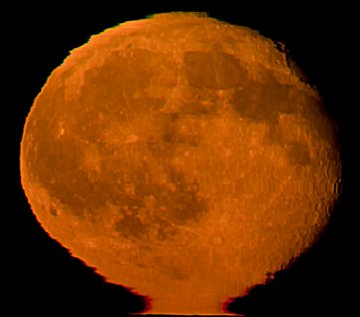
"The light of the Moon was refracted
by Earth's atmosphere so that the Moon's image bent
around the curvature of the earth. This caused it to
appear earlier than expected," explains Stetson.
Refraction also gave the Moon its
distorted shape, a
red fringe along the bottom and a
green fringe on top. Stetson documented the full
extent of the Moon's "playful illusions" in
this sequence of photos.
Readers, check the US Naval
Observatory's
web site to find moonrise times for your
hometown--and start watching early!
EXTRA: A more
detailed discussion of Stetson's photo by atmospheric
optics expert Les Cowley may be found
here.
|
9-7-09 - No sunspots today
Current conditions
Solar wind
speed: 353.1 km/sec
density: 3.6 protons/cm3
explanation |
more
data
Updated: Today at 1206
UT
X-ray Solar Flares
6-hr max: A0 1205
UT Sep07
24-hr: A0 1205 UT
Sep07
explanation |
more data
Updated: Today at: 1205
UT
ROCKETING
PLASMA BLOB: Solar activity is low,
but it's not zero. Consider the following: On Sept. 5th,
Jean-Paul Godard of Paris, France, was watching some
prominences gently wave over the edge of the sun when,
suddenly, a plasma blob rocketed into view:
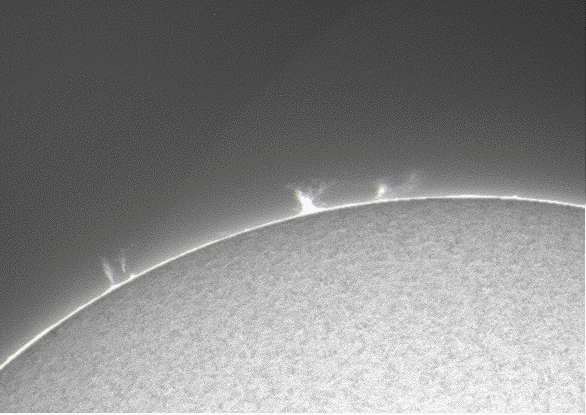
"I've never seen a fast ejection like this
before," says Godard. "I recorded
the action using a 3-inch refracting telescope and a
Coronado SolarMax filter."
The blob does not appear to have escaped
the sun. Indeed, it might not have been a blob at all, but
rather a plasma wave traveling up a magnetic flux
tube--and 'breaking' when it reached the top. Whether it
was a rocketing blob or breaking wave, it shows that even
the quiet sun is worth watching.
Monitoring is encouraged.
more images:
from Alan Friedman of Buffalo, New York;
from Cai-Uso Wohler of Bispingen, Germany;
from Francisco A. Rodriguez of Cabreja Mountain
Observatory, Canary Islands;
from Jimmy Eubanks of Boiling Springs, South Carolina;
from Pavol Rapavy of Observatory Rimavska Sobota,
Slovakia;
|
9-6-09 - No sunspots today
Current conditions
Solar wind
speed: 382.6 km/sec
density: 3.6 protons/cm3
explanation |
more
data
Updated: Today at 1925
UT
X-ray Solar Flares
6-hr max: A0 1920
UT Sep06
24-hr: A0 1920 UT
Sep06
explanation |
more data
Updated: Today at: 1920
UT
|
9-5-09 No sunspots today
Current conditions
Solar wind
speed: 399.4 km/sec
density: 3.4 protons/cm3
explanation |
more
data
Updated: Today at 2055
UT
X-ray Solar Flares
6-hr max: A0 2055
UT Sep05
24-hr: A0 0045 UT
Sep05
explanation |
more data
Updated: Today at: 2055
UT
SOLAR MINIMUM
VS. GLOBAL WARMING: From 2002 to
2008, decreasing solar irradiance has countered much
anthropogenic warming of Earth's surface. That's the
conclusion of researchers Judith Lean (NRL) and David Rind
(NASA/GISS), who have just published a new analysis of
global temperatures in the Geophysical Research
Letters. Lean and Rind considered four drivers of
climate change: solar activity, volcanic eruptions, ENSO
(El Nino), and the accumulation of greenhouse gases. The
following plot shows how much each has contributed to the
changing temperature of Earth's surface since 1980:
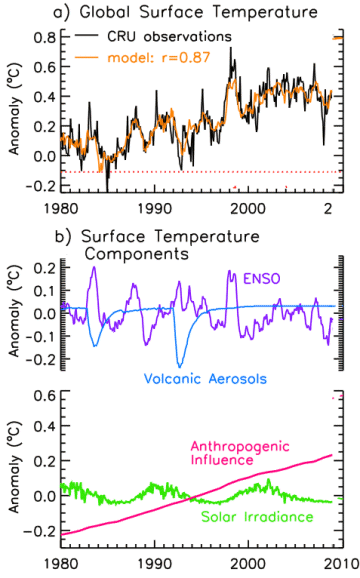
Volcanic aerosols are a source of cooling; ENSO and
greenhouse gases cause heating; the solar cycle can go
either way. When added together, these factors can account
for 76% of the variance in Earth's surface temperature
over the past ~30 years, according to the analysis of Lean
and Rind.
Several aspects of their model attract attention: "The
warmest year on record, 1998, coincides with the 'super-El
Nino' of 1997-98," points out Lean. "The ESNO is capable
of producing significant spikes in the temperature
record." Solar minimum has the opposite effect: "A 0.1%
decrease in the sun's irradiance has counteracted some of
the warming action of greenhouse gases from 2002 - 2008,"
she notes. "This is the reason for the well-known 'flat'
temperature trend of recent years."
What's next? Ultimately, the authors say, temperatures
will begin rising again as greenhouse gases accumulate and
solar activity resumes with the coming of the next solar
cycle. Of couse, the solar cycle could be
out of whack; if solar minimum deepens and persists,
no one is certain what will happen. Lean and Rind reveal
their predictions for the future
here.
Reference: Lean, J. L., and D. H. Rind
(2009), How will Earth's surface temperature change in
future decades?, Geophys. Res. Lett., 36, L15708
|
9-4-09 - No sunspots today
Current conditions
Solar wind
speed: 454.4 km/sec
density: 2.8 protons/cm3
explanation |
more data
Updated: Today
at 2344 UT
X-ray Solar Flares
6-hr max: A0
2340 UT Sep04
24-hr: A0
1650 UT Sep04
explanation |
more data
Updated: Today
at: 2340 UT
Are Sunspots Disappearing?
09.03.2009
September 3, 2009: The sun is in the
pits of the deepest solar minimum in nearly a century.
Weeks and sometimes whole months go by without even a
single tiny sunspot. The quiet has dragged out for
more than two years, prompting some observers to
wonder, are sunspots disappearing?
"Personally, I'm betting that sunspots are coming
back," says researcher Matt Penn of the National Solar
Observatory (NSO) in Tucson, Arizona. But, he allows,
"there is some evidence that they won't."
Penn's colleague Bill Livingston of the NSO has been
measuring the magnetic fields of sunspots for the past
17 years, and he has found a remarkable trend. Sunspot
magnetism is on the decline:
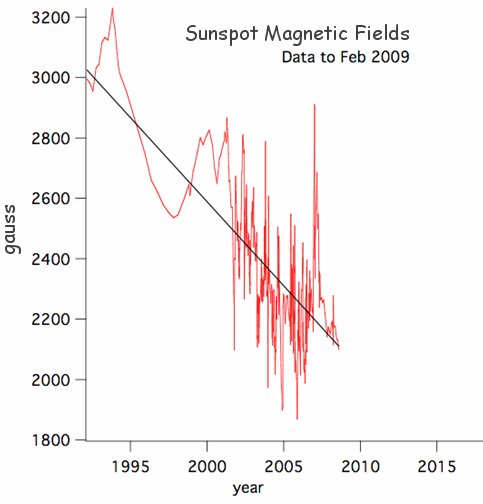
Above: Sunspot magnetic
fields measured by Livingston and Penn
from 1992 - Feb. 2009 using an infrared
Zeeman splitting technique. [more]
"Sunspot magnetic fields are dropping by
about 50 gauss per year," says Penn. "If
we extrapolate this trend into the future,
sunspots could completely vanish around
the year 2015."
This disappearing act is possible because
sunspots are made of magnetism. The
"firmament" of a sunspot is not matter but
rather a strong magnetic field that
appears dark because it blocks the upflow
of heat from the sun's interior. If Earth
lost its magnetic field, the solid planet
would remain intact, but if a sunspot
loses its magnetism, it ceases to exist.
"According to our measurements, sunspots
seem to form only if the magnetic field is
stronger than about 1500 gauss," says
Livingston. "If the current trend
continues, we'll hit that threshold in the
near future, and solar magnetic fields
would become too weak to form sunspots."
"This work has caused a sensation in the
field of solar physics," comments NASA
sunspot expert David Hathaway, who is not
directly involved in the research. "It's
controversial stuff."
The controversy is not about the data. "We
know Livingston and Penn are excellent
observers," says Hathaway. "The trend that
they have discovered appears to be real."
The part colleagues have trouble believing
is the extrapolation. Hathaway notes that
most of their data were taken
after
the maximum of Solar Cycle 23 (2000-2002)
when sunspot activity naturally began to
decline. "The drop in magnetic fields
could be a normal aspect of the solar
cycle and not a sign that sunspots are
permanently vanishing."
Penn himself wonders about these points.
"Our technique is relatively new and the
data stretches back in time only 17 years.
We could be observing a temporary downturn
that will reverse itself."
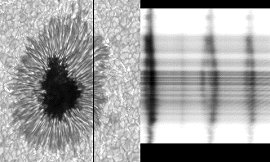
The technique they're using was pioneered
by Livingston at the McMath-Pierce solar
Livingston at the McMath-Pierce solar
telescope near Tucson. He looks at a
spectral line emitted by iron atoms in the
sun's atmosphere. Sunspot magnetic fields
cause the line to split in two—an effect
called "Zeeman splitting" after Dutch
physicist Pieter Zeeman who discovered the
phenomenon in the 19th century. The size
of the split reveals the intensity of the
magnetism.
Right: Zeeman splitting
of spectral lines from a
strongly-magnetized sunspot. [more]
Astronomers have been measuring sunspot
magnetic fields in this general way for
nearly a century, but Livingston added a
twist. While most researchers measure the
splitting of spectral lines in the visible
part of the sun's spectrum, Livingston
decided to try an infra-red spectral line.
Infrared lines are much more sensitive to
the Zeeman effect and provide more
accurate answers. Also, he dedicated
himself to measuring a large number of
sunspots—more than 900 between 1998 and
2005 alone. The combination of accuracy
and numbers revealed the downturn.
If sunspots do go away, it wouldn't be the
first time. In the 17th century, the sun
plunged into a 70-year period of
spotlessness known as the Maunder Minimum
that still baffles scientists. The sunspot
drought began in 1645 and lasted until
1715; during that time, some of the best
astronomers in history (e.g., Cassini)
monitored the sun and failed to count more
than a few dozen sunspots per year,
compared to the usual thousands.
"Whether [the current downturn] is an omen
of long-term sunspot decline, analogous to
the Maunder Minimum, remains to be seen,"
Livingston and Penn caution in a recent
issue of EOS. "Other indications of solar
activity suggest that sunspots must return
in earnest within the next year."
Whatever happens, notes Hathaway, "the sun
is behaving in an interesting way and I
believe we're about to learn something
new."
|
9-3-09 - No sunspots today
Current conditions
Solar wind
speed: 439.9 km/sec
density: 3.0 protons/cm3
explanation |
more data
Updated: Today
at 2347 UT
X-ray Solar Flares
6-hr max: A0
2340 UT Sep03
24-hr: A0
2340 UT Sep03
explanation |
more data
Updated: Today
at: 2340 UT
NOT-HARVEST MOON:
The full Moon of
September is often called the "Harvest
Moon" because farmers pre-Edison used its
light to harvest crops late into the
night. But tonight's full Moon is not the
Harvest Moon. It occurs too many days
before the autumnal equinox, Sept 22nd, to
have that name. Instead, the Harvest Moon
of 2009 will be on Oct. 4th.
|
9-2-09 - Sunspot 1025
Current conditions
Solar wind
speed: 369.6 km/sec
density: 0.5 protons/cm3
explanation |
more
data
Updated: Today at 1337
UT
X-ray Solar Flares
6-hr max: A0 1335
UT Sep02
24-hr: A0 1335 UT
Sep02
explanation |
more data
Updated: Today at: 1335
UT
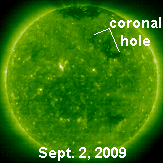
A solar wind stream flowing
from the indicated coronal hole
could reach Earth on Sept. 3rd or
4th.
Credit: SOHO Extreme UV Telescope
GEOMAGNETIC
MEGA-STORM: On Sept. 2nd, a
billion-ton coronal mass ejection (CME) slammed into
Earth's magnetic field. Campers in the Rocky Mountains
woke up in the middle of the night, thinking that the glow
they saw was sunrise. No, it was the Northern Lights.
People in Cuba read their morning paper by the red
illumination of aurora borealis. Earth was peppered by
particles so energetic, they altered the chemistry of
polar ice.Hard to believe? It really happened--exactly
150 years ago. This map shows where auroras were sighted
in the early hours of Sept. 2, 1859:
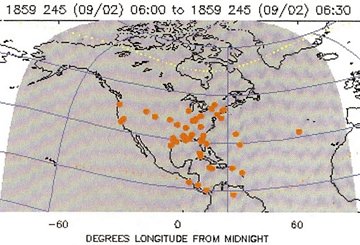
Above: Aurora sightings,
Sept. 2, 1859. Image courtesy J.L. Green, NASA
As the day unfolded, the gathering storm
electrified telegraph lines, shocking technicians and
setting their telegraph papers on fire. The "Victorian
Internet" was knocked offline. Magnetometers around the
world recorded strong disturbances in the planetary
magnetic field for more than a week.
The cause of all this was an
extraordinary solar flare witnessed the day before by
British astronomer Richard Carrington. His sighting marked
the discovery of solar flares and foreshadowed a new field
of study: space weather. According to the National Academy
of Sciences, if a similar flare occurred today, it would
cause $1 to 2 trillion in damage to society's high-tech
infrastructure and require four to ten years for complete
recovery.
A repeat of the Carrington Event seems
unlikely from our low vantage in a deep solar minimum--but
don't let the quiet fool you. Strong flares can occur even
during weak solar cycles. Indeed, the Carrington flare
itself occurred during a relatively weak cycle similar to
the one expected to peak in
2012-2013. Could it happen again?
Let's hope not.
August 2009 Aurora Gallery
[previous Augusts:
2008,
2007,
2006,
2005,
2004,
2003,
2002,
2001
|
|
9-1-09 - Sunspot 1025
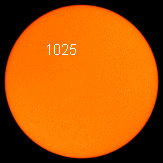
SUNSPOT 1025: A new
sunspot emerged yesterday and interrupted a
51-day string of blank suns. It wasn't much of
an interruption. Sunspot 1025 is small and may
already be fading away. Readers with
solar telescopes are encouraged to
monitor
the
situation.
Current conditions
Solar wind
speed: 376.3 km/sec
density: 0.6 protons/cm3
explanation |
more data
Updated: Today
at 2346 UT
X-ray Solar Flares
6-hr max: A0
2340 UT Sep01
24-hr: A0
2340 UT Sep01
explanation |
more data
Updated: Today
at: 2340 UT
|
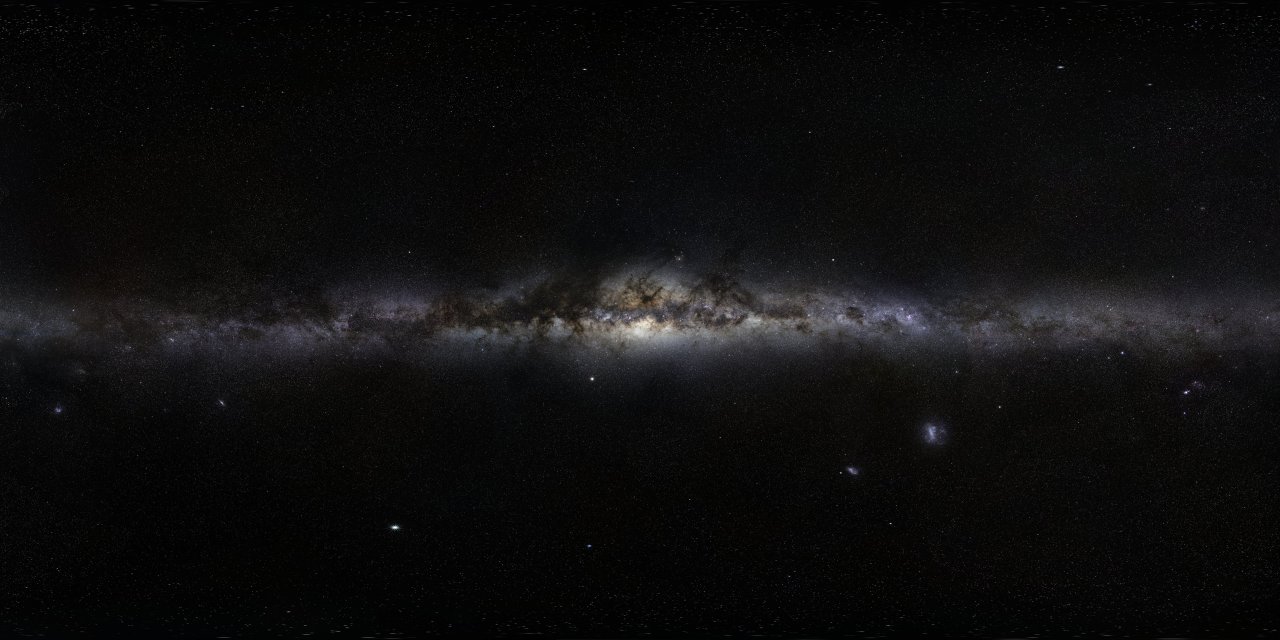
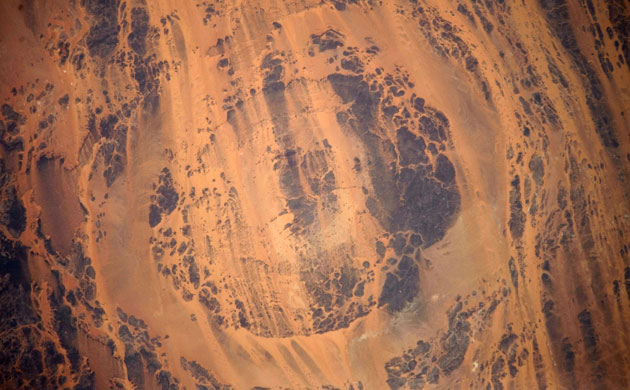




 Italian amateur astronomer Rolando Ligustri took the
picture on Sept. 26th using a 4-inch wide field
Global Rent-a-Scope in New Mexico. He needed 15
minutes of exposure time to reveal the green comet
among the gas and dust of Orion's great star-forming
region. The comet is receding from the nebula now,
but still close enough for some nice parting shots.
Astrophotographers who wish to try can use
Italian amateur astronomer Rolando Ligustri took the
picture on Sept. 26th using a 4-inch wide field
Global Rent-a-Scope in New Mexico. He needed 15
minutes of exposure time to reveal the green comet
among the gas and dust of Orion's great star-forming
region. The comet is receding from the nebula now,
but still close enough for some nice parting shots.
Astrophotographers who wish to try can use


































